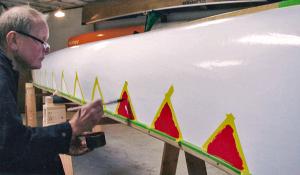Canoe House project bringing communities together to preserve history at Camp Bishop
Posted on: Mar, 27, 2017
A piece of history has come full circle at Camp Bishop, and the carpentry program at Grays Harbor College is doing its part to preserve it.
It all started in 1947, when the American Red Cross commissioned a large canoe for use in water safety training and canoeing classes at the camp near Shelton, run by the YMCA of Grays Harbor. The 25-foot canvas-on-wood craft, brightly painted in a Native American style, was an integral part of the camp’s water programs for decades. After it was retired in the early 1970s, it faded from memory and disappeared.
But Vern Heikkila never forgot about it. The Westport canoe expert made it his mission to track down the old watercraft that held so many childhood memories for him. He eventually discovered it tangled in blackberry bushes across from the Aberdeen Museum of History. The canvas had rotted away, but the frame was intact.
Guided by historical information on file, Heikkila restored it to its former glory over the course of two years — reinforcing, recanvasing and repainting with the original design. Once it was finished, he hauled the canoe back to Camp Bishop for three summers and used it for its original purpose: to teach kids canoeing and water safety.
During a Woodworkers Guild meeting in May 2013, he discussed his labor of love with Adam Pratt, GHC’s carpentry instructor. Pratt recalls Heikkila telling him: “I can’t be hauling this canoe back and forth all the time. Can you put a roof over it and keep it dry?” The idea was simply to build a lean-to: four posts and a roof. Pratt said sure, he could do that.
Then architect Will Foster of Montesano entered the picture, proposing a structure in the general shape of a canoe, with nods to historical timber construction and Native American styling. It would not only house the 25-foot canoe, but also include racks for the camp’s many smaller canoes and storage for other related equipment. This was “not a lean-to,” Pratt laughs.
At that point, he decided he wanted to get his carpentry students involved.
“I said if you can get it funded, then we’ll build it — and that was a very silly thing for me to do,” Pratt chuckles, “because they did fund it, and now we have to build it.”
YMCA of Grays Harbor is partnering with GHC on the Canoe House. YMCA CEO Franzine Potts is pleased that everything is coming together for the project. “We are very excited about the collaboration, truly a great combined effort within our community,” she said in a news release.
The organizers have amassed donations totaling nearly $170,000 in cash, materials and services specifically earmarked for the structure at Camp Bishop. The concrete footings were laid last summer; students now are building the plinths that will hold the timber frame in place.
Pratt says he’s restructured GHC’s entire carpentry course around the Canoe House.
“There’s a high level of learning involved in the project, but we’re trying to balance that by compressing our normal curriculum into seven weeks,” he says, “leaving us approximately three weeks at the end of the quarter to drive out to Camp Bishop.”
It’s been an excellent learning experience so far, he says — notably, navigating the “intense and thorough” wetland permitting process, which took plenty of time and money to complete.
Pratt says GHC is planning a six-week summer carpentry course for those interested in continuing work on the project. No completion date has been set, he adds: “It depends on how fast the students can work.”
For their part, his students have taken the project to heart.
Jason Brown, who’s been in the carpentry program for two years, helped build the Canoe House model. “It’s pretty good, huh?” he says with a grin.
He and Kim Smith, who’s been part of the program for a year and a half, both like the fact that students from all six course levels are working together on it. The more advanced students are constantly mentoring the others, Smith says, and “it’s really nice to see the teamwork.”
Even some who have graduated are still working on the project.
Pointing to the roofline of the Canoe House model in the GHC wood shop, Pratt says, “We’ve invited the Quinault Indian Nation to create this decorative headpiece in an artistic form to represent their style. They’re still in discussion on whether they want to do that.” He says one of his recent grads, a Quinault member, is still trying to get his community involved in the project because they conduct programs at Camp Bishop for Quinault Nation kids, too.
Pratt says the project is stirring a general renewal of interest and support in the YMCA camp and its programming, but he adds there’s an even deeper need for it.
At its core, “it’s about bringing different people together,” he says. “Canoe House has become a symbol — an excuse — to build some community.”
CANOE HOUSE DONATIONS
Organizers have raised more than $168,000 worth of donations to date for the Canoe House. They’re still seeking aid from gravel companies, roofing contractors, volunteer laborers and more. For information on how to help, contact Adam Pratt at adam.pratt@ghc.edu.
$50,800 — construction labor GHC carpentry class
$50,000 — cedar lumber from Rick and Ellen Middleton, Anderson & Middleton Construction
$30,000 — Grays Harbor Community Foundation grant
$12,700 — architectural services by Will Foster, SLF Architects
$9,000 — steel fabrication services from Tim Kuhn, A&B Machine
$5,150 — cash for wetlands survey and land-use permits, from an anonymous donor
$3,000 — cash from Edith Middleton
$3,000 — cash from the Wood Canoe Heritage Association
$3,000 — cash for structural engineering from YMCA Grays Harbor
$1,000 — excavation services by John Brumfield, Brumfield Construction
$1,000 — steel from Western Steel
